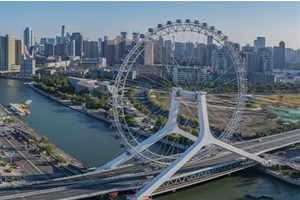Where is a three-day tour suitable for traveling?
The best places for a three-day tour around Chengdu are Dujiangyan Scenic Area-Wuhou Temple-Qingcheng Mountain-Du Fu Caotang-Xiling Snow Mountain-Wangjianglou-Wenshuyuan-Tiantai Mountain-Qingyang Palace-Baoguang Temple.
Chengdu is one of the first national historical and cultural cities, the birthplace of ancient Shu civilization and the best tourist city in China. Jinsha Site in China has a history of 3,000 years. Zhou Taiwang is named Chengdu because it is "a city in one year, a city in two years and a city in three years".
Dujiangyan Scenic Area:It is the oldest and only water conservancy project in the world so far, which is characterized by dam-free water diversion. It mainly consists of three parts: the fishmouth water diversion dike, the spillway of Feisha weir and the water inlet of the bottle mouth, which has been playing the role of flood control and irrigation.
Wuhou Temple:It commemorates Zhuge Liang, the prime minister of Shu, who was incorporated into the Zhaolie Temple in Han Dynasty in the early Ming Dynasty and is also the most influential museum of the Three Kingdoms relics in China. It consists of Huiling, Han Zhaolie Temple and Wuhou Temple. There are 50 statues of heroes of Shu and Han dynasties, such as Liu Bei and Zhuge Liang.
Qingcheng Mountain:Located in the west of Dujiangyan, it is one of the birthplaces of Taoism, and is known as "Qingcheng is a quiet place in the world". It is divided into two scenic spots: Qianshan Mountain and Houshan Mountain. Most tourists go to Qianshan Mountain, and Houshan Mountain is more suitable for mountain climbers.
Du Fu Caotang:Du Fu's former residence when he lived in Chengdu. Du Fu lived here for nearly four years and wrote hundreds of poems, which is regarded as the "holy land" in the history of China literature. Today's Du Fu Cottage was restored many times in Song, Yuan, Ming and Qing Dynasties. There are many pavilions and pagodas in the garden, and ancient trees are towering.
Xiling Snow Mountain:World natural heritage, giant panda habitat, national scenic spots, national forest parks and AAAA-level tourist attractions. The highest peak in the scenic spot, Daxuetang, is about 5364 meters above sea level, making it the first peak in Chengdu.
Wangjianglou:Wangjianglou in Chengdu is located in wangjiang tower park, Chengdu, and wangjiang tower park is located in the south bank of Jinjiang, Jiuyan Bridge, outside the east gate of Chengdu, with an area of 176.5 mu. On the inner bank of the park, there are willow columns, sparkling buildings, bamboos and pavilions, and the main buildings are Chongli Tower, Zhuojin Building, Huanjian Pavilion, Wuyunxian Pavilion, Liubeichi and Quanxiangxie. It is a famous female poet in the Ming and Qing Dynasties to commemorate the Tang Dynasty.
Wenshuyuan:Wenshu Academy, founded in the Sui Dynasty, is a famous Buddhist temple in western Sichuan, with many precious cultural relics and tens of thousands of Buddhist scriptures and documents. There are the Temple of the King of Heaven, the Hall of the Three Masters, the Hall of the Great Heroes, etc., and there are also more than 300 Buddha statues in size.
Tiantai Mountain:Tiantai Mountain is a rare box-shaped syncline mountain in China. Danxia landform is rich in changes, and there is a saying that Tiantai Tiantai is the platform for ascending to heaven. There are dense forests in the scenic area, and Qingxi Waterfall can be seen everywhere. The most famous waterfall is Xiangshuitan Waterfall, which is the largest waterfall in western Sichuan.
Qingyang Palace:Founded in the Zhou Dynasty, most of the existing buildings were rebuilt in the Qing Dynasty. It is one of the famous Taoist temples in China and is known as "the first Taoist temple in western Sichuan". In the palace, there is an extremely precious Taoist historical relic "Collection of Taoist Books" engraved during Guangxu period, which is the most complete preserved board of Taoist classics in China.
Baoguang Temple:Baoguang Temple, formerly known as Hokkeji, is a key protected cultural relic in Tongzhou District. Guangsi enters south, and there is a bell tower in the mountain gate, with a bronze bell hanging inside. The clock body is cast with "Daming Jingtai". There is a brick pagoda behind the main hall, named Dingguang Buddhist relic pagoda. In the Tangshan earthquake in 1976, the Dingguang Tower collapsed, and five exquisite bronze mirrors were unearthed in the treasure box (one in the southeast, one in the northwest and one in the middle), as well as one bronze medal, one bronze horse and one bronze tower, and one scripture.
Suzhou, located in the southeast of Jiangsu Province, is an ancient city with a history of more than 2,500 years, and is known as the "water town in the south of the Yangtze River" and "Venice in the East". Suzhou is rich in natural scenery and cultural landscape, attracting countless tourists to visit. The following is a three-day travel guide to Suzhou, hoping to provide reference for your journey.
Day 1: Humble Administrator's Garden, Suzhou Museum, Pingjiang Road and Guanqian Street.
Morning: First, visit Humble Administrator's Garden, which is one of the four famous gardens in China and is known as the "Mother of Jiangnan Gardens". Humble Administrator's Garden is famous for its unique garden art and beautiful natural landscape. Visitors can enjoy the typical style of Jiangnan gardens here.
Noon: Taste Suzhou's special food in a nearby restaurant, such as Sweet and Sour Mandarin Fish, sesame oil eel paste, etc.
Afternoon: Visit Suzhou Museum, which is a museum integrating modern architecture and traditional gardens. The museum has a large collection of historical relics in Suzhou. Then, stroll along Pingjiang Road and feel the historical charm of the ancient city of Suzhou. Pingjiang Road is an antique old street with many specialty shops and handicraft shops on both sides.
晚上:逛观前街,这是苏州最繁华的商业街区,汇集了各种购物、餐饮和娱乐场所。游客可以在这里购买苏州特色的丝绸、扇子等纪念品,还可以品尝当地的小吃。
第二天:虎丘、寒山寺、山塘街
上午:游览虎丘,这是苏州著名的旅游景点之一,有着丰富的历史文化底蕴。虎丘上有许多著名的景点,如云岩寺塔、剑池等。
中午:在附近的餐馆品尝苏州的特色美食。
下午:参观寒山寺,这是一座有着1500多年历史的古刹,是中国佛教禅宗的发源地之一。随后,漫步山塘街,这是一条充满古韵的街道,两旁有许多特色小店和手工艺品店。
晚上:在山塘街附近的餐馆品尝苏州的特色美食。
第三天:周庄古镇
上午:前往周庄古镇,这是一座典型的江南水乡古镇,有着近千年的历史。游客可以在这里欣赏到古老的石桥、古朴的建筑和美丽的水景。
中午:在周庄古镇品尝当地的特色美食。
下午:游览周庄古镇的各个景点,如沈万三故居、张厅等。随后,乘坐游船游览周庄的水道,欣赏古镇的美丽风光。






